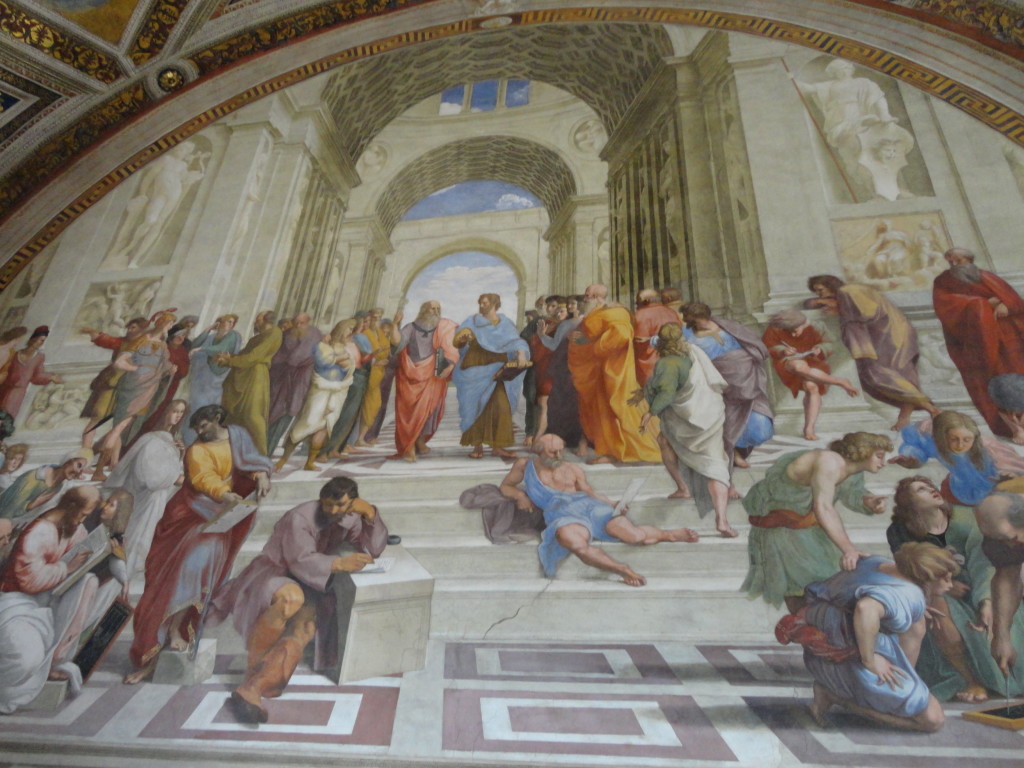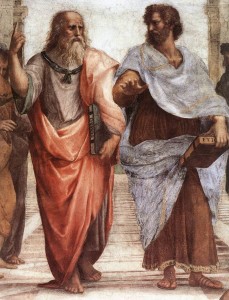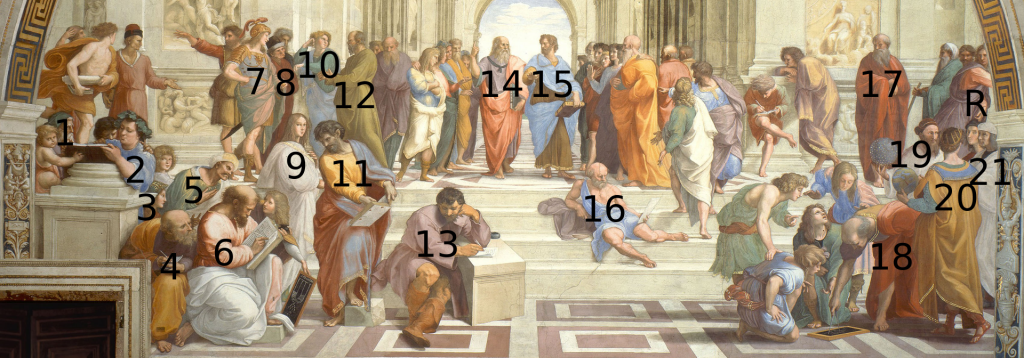Today* is the birthday of Raffaelo Sanzio da Urbino, or as we better know him, the painter Raphael. A contemporary of Michelangelo and Leonardo da Vinci, Raphael sometimes gets lost in their long shadows of memory. His art and capability, however, can arguably be said to outshine even those two masters.
I had the pleasure of seeing in person what is perhaps Raphael’s greatest work; it is certainly his best known. The School of Athens is a fresco decorating an entire wall in the Apostolic Palace in the Vatican.

It took two years to paint the fresco, all while Michelangelo was down the hall painting the famous ceiling of the Sistine Chapel. Raphael also painted many other walls in the Vatican, but The School of Athens was to be the apex of his career.
And he had fun with it. The School is one of four paintings on the walls of the palace depicting the four distinct branches of knowledge (Philosophy, Poetry [including music], Theology, and Law). The actual title given to the fresco is Causarum Cognitio, which translates roughly into “Seeking Knowledge of Causes.” While Raphael left no explanation for the figures, many have been identified as famous philosophers.

The only two undisputed figures are the two most obvious in the center of the crowd. Carrying their respective master treatises, Plato (Timaeus) on the left with his protégé Aristotle (Ethics) on the right.Their hand gestures are said to signify central aspects of their philosophies. Plato’s upward point at the vaulted ceiling contrasted with Aristotle’s more down-to-earth horizontal plane positioning. These may suggest a divergence of the two philosophical schools: the elder Plato arguing a sense of timeliness while the younger Aristotle focuses on the present and the physicality of life.
Plato vertically, upward along the picture-plane, into the beautiful vault above; Aristotle on the horizontal plane at right-angles to the picture-plane (hence in strong foreshortening), initiating a powerful flow of space toward viewers. It is popularly thought that their gestures indicate central aspects of their philosophies, for Plato, his Theory of Forms, and for Aristotle, his empiricist views, with an emphasis on concrete particulars. Many interpret the painting to show a divergence of the two philosophical schools. Plato argues a sense of timelessness whilst Aristotle looks into the physicality of life and the present realm.
Of course, since no one knows what Plato actually looked like, Raphael painted him to look a lot like a certain Leonardo da Vinci. Similarly, Aristotle is painted in the visage of sculptor Giuliano da Sangallo.
Beyond these two the identifications get dicier. The following comes from the Wiki page for the painting (click on the link to see the names):

Those that are more or less identified with certainty, in addition to Plato and Aristotle, are Socrates, Pythagoras, Euclid, Ptolemy, Zoroaster, Raphael (painters love to paint themselves into their art), Sodoma, and Diogenes. Others are more speculative. Since Raphael and Michelangelo were not particularly friendly rivals, the rather frumpy looking depiction of pre-Socrates Greek philosopher Heraclitus (#13 in photo above) just happens to look like Michelangelo.
By the way, the two big sculptures in the background are Apollo (left) and Athena (right).
A quick note about fresco. Derived from the Italian word for “fresh,” fresco is a technique of mural painting in which pigments are mixed in wet lime plaster and applied to walls and ceilings. As the plaster dries it becomes an integral part of the wall. It is notoriously difficult to work with, which is why they are so amazing to see today. Other great examples are down the hall in the Sistine Chapel.
Ironically, today is also the anniversary of Raphael’s death in 1520, apparently caused by a fever caught after a debaucherous night of excessive sex with his mistress. He was only 37. Raphael’s influence was so great that he was buried in Rome’s Pantheon.
*There is some question as to whether his birthday was April 6 or March 28 (Good Friday). Either way, he was born in Urbino, a small but “artistically significant” city in central Italy.
[Photo credits: 1st: Ru Sun; 2nd and 3rd: Wiki]
David J. Kent is the author of Tesla: The Wizard of Electricity (2013) and Edison: The Inventor of the Modern World (2016) (both Fall River Press). He has also written two e-books: Nikola Tesla: Renewable Energy Ahead of Its Time and Abraham Lincoln and Nikola Tesla: Connected by Fate. His next book is on Abraham Lincoln, due out in 2017.
Follow me by subscribing by email on the home page. And feel free to “Like” my Facebook author’s page and connect on LinkedIn. Share with your friends using the buttons below.










